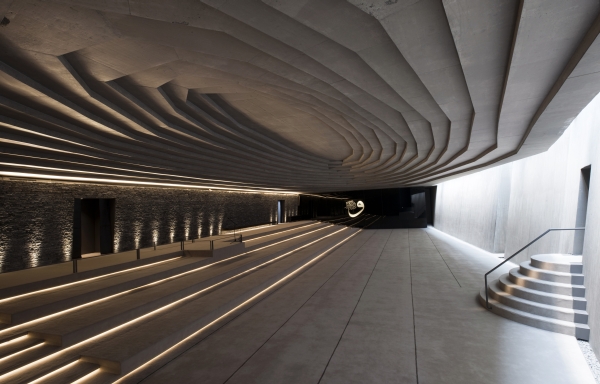Piercing Light
Sancaklar Mosque, Istanbul
Architect: Emre Arolat
Text: Vilmos Katona
Photos: Cemal Emden, Thomas Mayer

Modernism in Turkey had for a long time been synonymous with national Historicism adapted to the utilization of reinforced concrete. It is quite recently that architects have been given the chance to rediscover local and traditional building materials to resolve the conflict of forms and structure by relying upon standards and quality. However, besides the rehabilitation of natural construction, monumentalism as well as central spatial organization completed with a cupola have remained taboos so far. The variety of components rated by religious practice as auxiliary ones are enriched by ornaments and calligraphy. Texts from the Quran painted or used as reliefs on the walls and vaults are typically integrated in the design and thus cannot be distinguished from botanical decorations of architecture. Their lack is a most striking feature of the new religious centre in Istanbul, where their functions are taken over by the texture of materials, such as the slate layers on the brickwork, the basalt integrated in the floor, the tracery of exposed concrete in the ceiling as well as in the courtile and the interior walls of the qibla showing the direction to face when praying. Differing from the usual design, the composition is unobtrusive, just like the hidden character of the bulk of the building mass on the sloping terrain. The building functions like an anchor that does not show shiny Platonic bodies besides a cave, which is like a quintessence offering a shelter for god-searching minds. Opening up at several points, this complex is a well-defined one owing to its materials and compact forms that express a majestic unity of architecture and its context. A community and its home, a house and nature are entwined here and now as a unique interpretation meant for a new period of Islamic architecture.
Architecture: Emre Arolat Architects
Leading architect: Emre Arolat
Fellow architects: Leyla Kori, Nil Aynalı, Taha Alkan, Ünal Ali Özger, Oya Eskin Güvendi, Uygar Yüksel
Sancaklar Mosque, Istanbul
Architect: Emre Arolat
Text: Vilmos Katona
Photos: Cemal Emden, Thomas Mayer

Modernism in Turkey had for a long time been synonymous with national Historicism adapted to the utilization of reinforced concrete. It is quite recently that architects have been given the chance to rediscover local and traditional building materials to resolve the conflict of forms and structure by relying upon standards and quality. However, besides the rehabilitation of natural construction, monumentalism as well as central spatial organization completed with a cupola have remained taboos so far. The variety of components rated by religious practice as auxiliary ones are enriched by ornaments and calligraphy. Texts from the Quran painted or used as reliefs on the walls and vaults are typically integrated in the design and thus cannot be distinguished from botanical decorations of architecture. Their lack is a most striking feature of the new religious centre in Istanbul, where their functions are taken over by the texture of materials, such as the slate layers on the brickwork, the basalt integrated in the floor, the tracery of exposed concrete in the ceiling as well as in the courtile and the interior walls of the qibla showing the direction to face when praying. Differing from the usual design, the composition is unobtrusive, just like the hidden character of the bulk of the building mass on the sloping terrain. The building functions like an anchor that does not show shiny Platonic bodies besides a cave, which is like a quintessence offering a shelter for god-searching minds. Opening up at several points, this complex is a well-defined one owing to its materials and compact forms that express a majestic unity of architecture and its context. A community and its home, a house and nature are entwined here and now as a unique interpretation meant for a new period of Islamic architecture.
Architecture: Emre Arolat Architects
Leading architect: Emre Arolat
Fellow architects: Leyla Kori, Nil Aynalı, Taha Alkan, Ünal Ali Özger, Oya Eskin Güvendi, Uygar Yüksel
A lot of pupils are unable to come up with proper and interesting essay and if this is the
Writing https://www.affordable-papers.net/ an article does not need to be hard.
case, it is time that one goes ahead and gets assistance from a composition helper that will look after all of your academic and writing duties.







